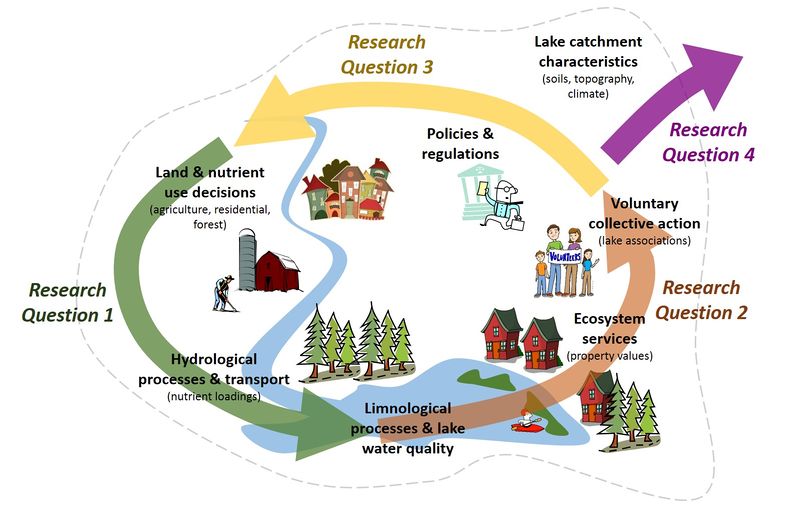Main Page
Contents
CNH-L: Linking land-use decision making, water quality, and lake associations to understand human-natural feedbacks in lake catchments
Worldwide, people benefit greatly from the irreplaceable services provided by freshwater lakes, such as drinking water, recreation, and fisheries. However, human activities in lake catchments contribute to eutrophication and the growth of harmful algal blooms that threaten the very waters upon which people depend. This degradation can generate incentives for behavioral change. For example, lake associations can initiate citizen-driven actions to protect and improve water quality, but will this action come in time and focus on the key drivers of water quality.
This project examines the linkages between land-use decision making, fate-transport of nonpoint source pollution to lakes, lake water quality, the effects of water quality on property values, and the community responses that stimulate changes in land uses. In three lake catchments that vary in the intensity of agriculture, forested land and residential development we build the linkages from land use to water quality to identify the key drivers of lake water quality.
The insights from the three focal catchments will inform the understanding of human-natural system dynamics across thousands of lake catchments spanning the northeastern and midwestern U.S. An understanding of the relationships between and lake water quality and land-use policies will be leveraged to support science-based monitoring, advocacy and volunteerism to develop effective programs to protect and enhance lake water quality.
News & Project Events
Check out the Virginia Tech press release about the project at this link.
Our Multidisciplinary Team
This project builds on a strong collaboration among a diverse team of researchers from multiple disciplines and institutions, as well as citizen science groups. Our team's expertise spans the fields of freshwater ecology, environmental and resource economics, hydrology, and social science.
Project Leadership
- Kelly Cobourn, Virginia Tech, lead Principal Investigator. Cobourn is an agricultural and resource economist with experience in bio-economic modeling.
- Cayelan Carey, Virginia Tech, Principal Investigator. Carey is a freshwater ecologist whose research focuses on understanding the causes and effects of eutrophication in lakes.
- Kevin Boyle, Virginia Tech, Principal Investigator. Boyle is an environmental economist who specializes in the development of hedonic models of the impacts of changes in lake water quality on property values.
Co-Principal Investigators
- Chris Duffy, The Pennsylvania State University, Hydrologist
- Armen Kemanian, The Pennsylvania State University, Biological Systems Engineer
- Paul Hanson, University of Wisconsin, Aquatic Ecologist
- Michael Sorice, Virginia Tech, Social Scientist
- Pat Soranno, Michigan State University, Landscape Limnologist
- Kathleen Weathers, Cary Institute of Ecosystem Studies, Biogeochemist
Students and Postdoctoral Researchers
We are fortunate to have a number of graduate and undergraduate students and postdoctoral researchers involved in the project:
- Amy Hetherington has a Ph.D. in Natural Resources from Cornell University. She worked closely with Lars Rudstam and Kathleen Weathers on her dissertation, which examines the effects of climate on lake ecosystems. Amy is joining the project team as a Postdoctoral Researcher at Virginia Tech in February, 2016.
- Weizhe Weng is a Ph.D. student in Agricultural and Applied Economics at Virginia Tech. She is co-advised by Kevin Boyle and Kelly Cobourn at Virginia Tech. Her graduate research examines the effects of farmers' land-use and nutrient use decisions on lake water quality and the effect of changes in lake water quality on housing values.
Contributing and Participating
Our extended collaborative includes several scientists and lake associations, including:
- Lars Rudstam, Cornell University
- Jennifer Klug, Fairfield University
- Michael Vanni, Miami University
- Clean Lakes Alliance, Lake Mendota, WI
- Lake Sunapee Protective Association, Lake Sunapee, NH
- Oneida Lake Association, Lake Oneida, NY
Research Objectives
This project seeks to address 4 main questions:
- Research Question 1: How do human land-use decisions interact with catchment biophysical characteristics to influence the effects of nutrient loading on lake water quality?
- Research Question 2: What are the essential management variables (EMVs) in coupled lake-catchment systems, and at what temporal resolution must those variables be measured to detect feedbacks from natural to human systems?
- Research Question 3: How does collective action affect land-use decision making and policies at the local, catchment, and state levels to alter nutrient loading and impact lake water quality?
- Research Question 4: What are the key generalizations that can be derived from the focal catchments to understand how water quality and human activity are linked at the regional to continental scale?
Models
Hydrological Modeling: Pennsylvania Integrated Hydrological Model (PIHM); Cycles (CropSyst)
- Leads: Chris Duffy, Armen Kemanian
Agricultural Economic Modeling: Stochastic Dynamic Programming (SDP)
- Lead: Kelly Cobourn
Limnological Modeling: General Lake Model (GLM)
- Leads: Cayelan Carey, Paul Hanson
Economic Property Value Modeling: Hedonic Model
- Lead: Kevin Boyle
Collective Action Modeling: Social Science Model
- Lead: Michael Sorice
Scaling up and extrapolation: LAke multi-scaled GeOSpatial and temporal database (LAGOS)
- Leads: Pat Soranno, Cayelan Carey, Kelly Cobourn
Our Study Lakes
Our focal lake catchments for this study are:
- Lake Mendota, Wisconsin
- Lake Sunapee, New Hampshire
- Lake Oneida, New York
Our collaborators on this project also bring insights to our modeling efforts from their work on:
- Lake Lillinonah, Connecticut
- Acton Lake, Ohio
In addition, the project's scaling up and extrapolation efforts extend our work in these catchments to a broader set of lakes that spans the Upper Midwest, North Central, and North Eastern United States using the LAGOS database.
Broader Impacts
This project builds on an ongoing collaboration with our Lake Association partners in each of our focal lake catchments. These associations are civic organizations that engage in outreach and education within and among catchment communities.
Acknowledgments
This work is supported as a grant from the National Science Foundation, Dynamics of Coupled Natural and Human Systems (CNH) program, award number 1517823.
MediaWiki Pointers
This site is built with the Organic Data Science framework, which is developed using the MediaWiki and Semantic MediaWiki platforms.
Here is a Quick Reference Guide for How to Use This Wiki Site.

